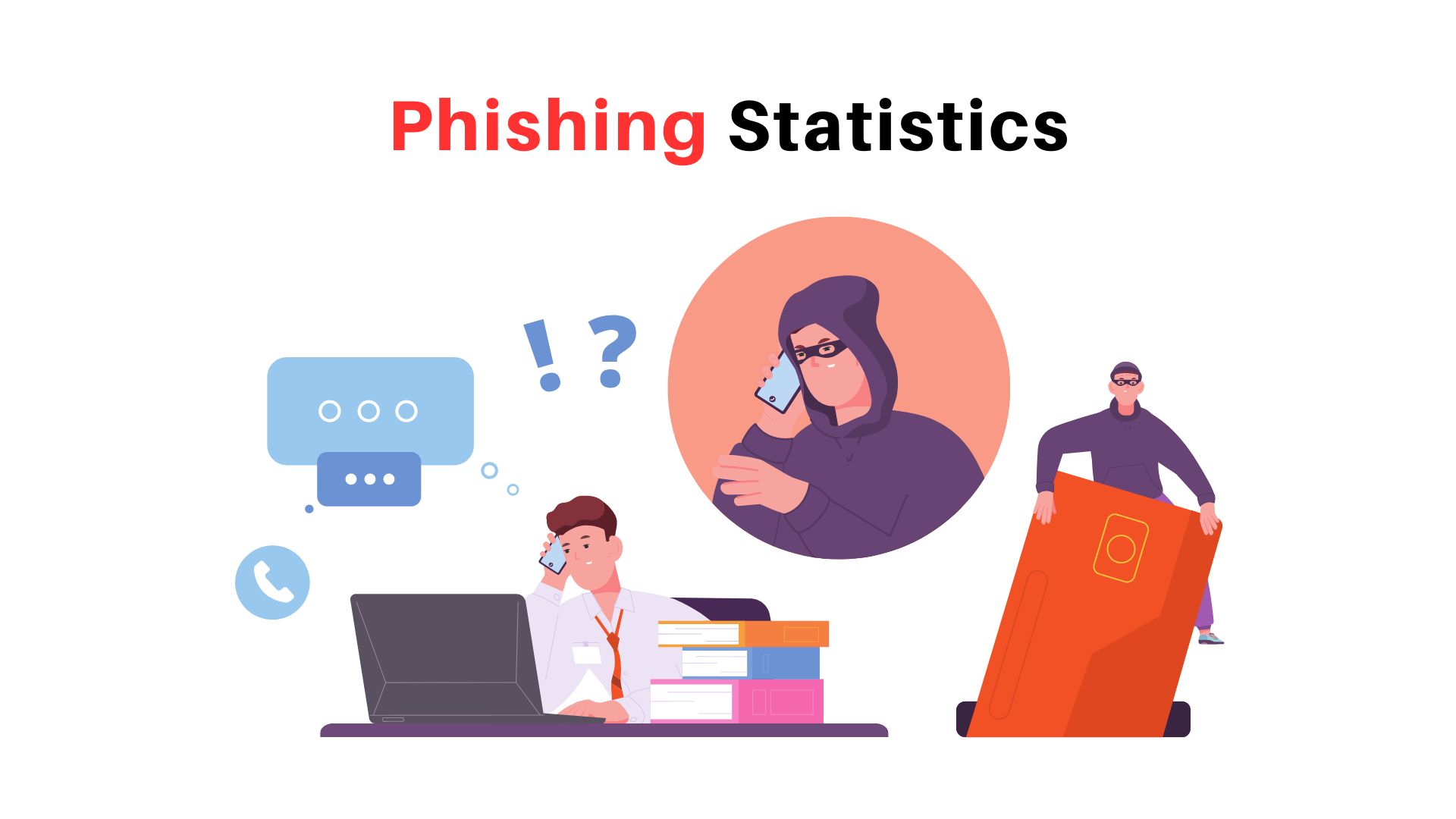Fake News Statistics By Region, Demographic and Effect on Politics
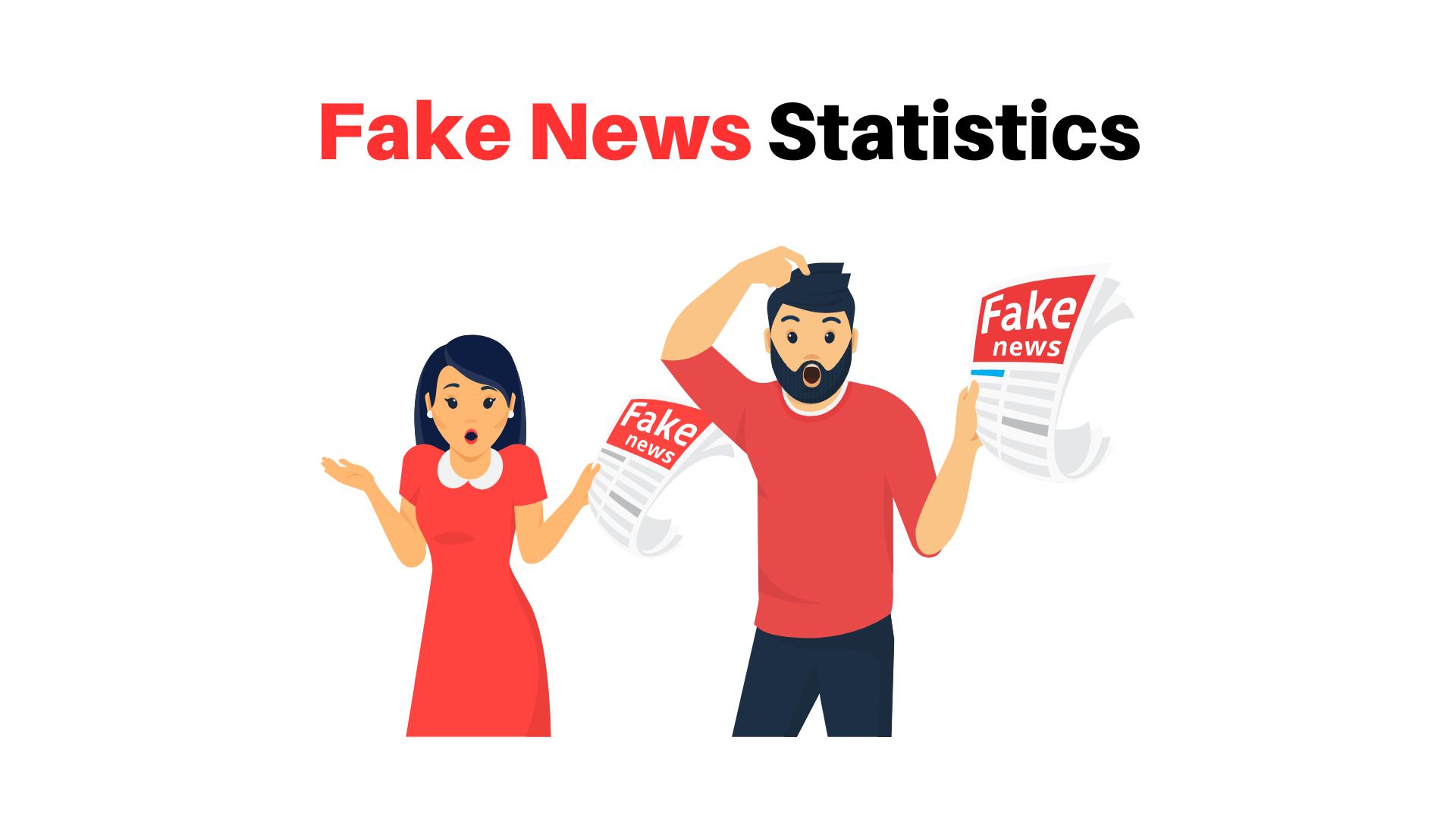
Page Contents
- Introduction
- Editor’s Choice
- What is Fake News?
- How Often Do You See Fake News?
- Statistics on Trust in Social Media
- General Statistics on Fake News
- Fake News Statistics Effect on Politics
- Trust in Social Media By Region and Demographic
- Impact of Fake News on People and The Economy
- Fake News and Covid-19
- How to Stop Fake News from Spreading?
- Final Words
Introduction
Fake News Statistics: Fake news refers to any false or inaccurate information presented as news and is becoming an increasing problem as social media and the internet have grown more popular. Recent years have witnessed an explosion of research and publications addressing the effects and incidence of false news reports, with two-thirds of American adults believing that false reports greatly mislead about current events according to research conducted by Pew Research Center. A study by the Reuters Institute for the Study of Journalism also showed that 55% of respondents are concerned with false news; its effect has even been evident in politics. Researchers from Stanford University conducted a study, showing that during the 2016 U.S. presidential election, fake news items were more likely to be shared on social media than actual news reports – underscoring the necessity of spreading knowledge and raising awareness regarding false news issues.
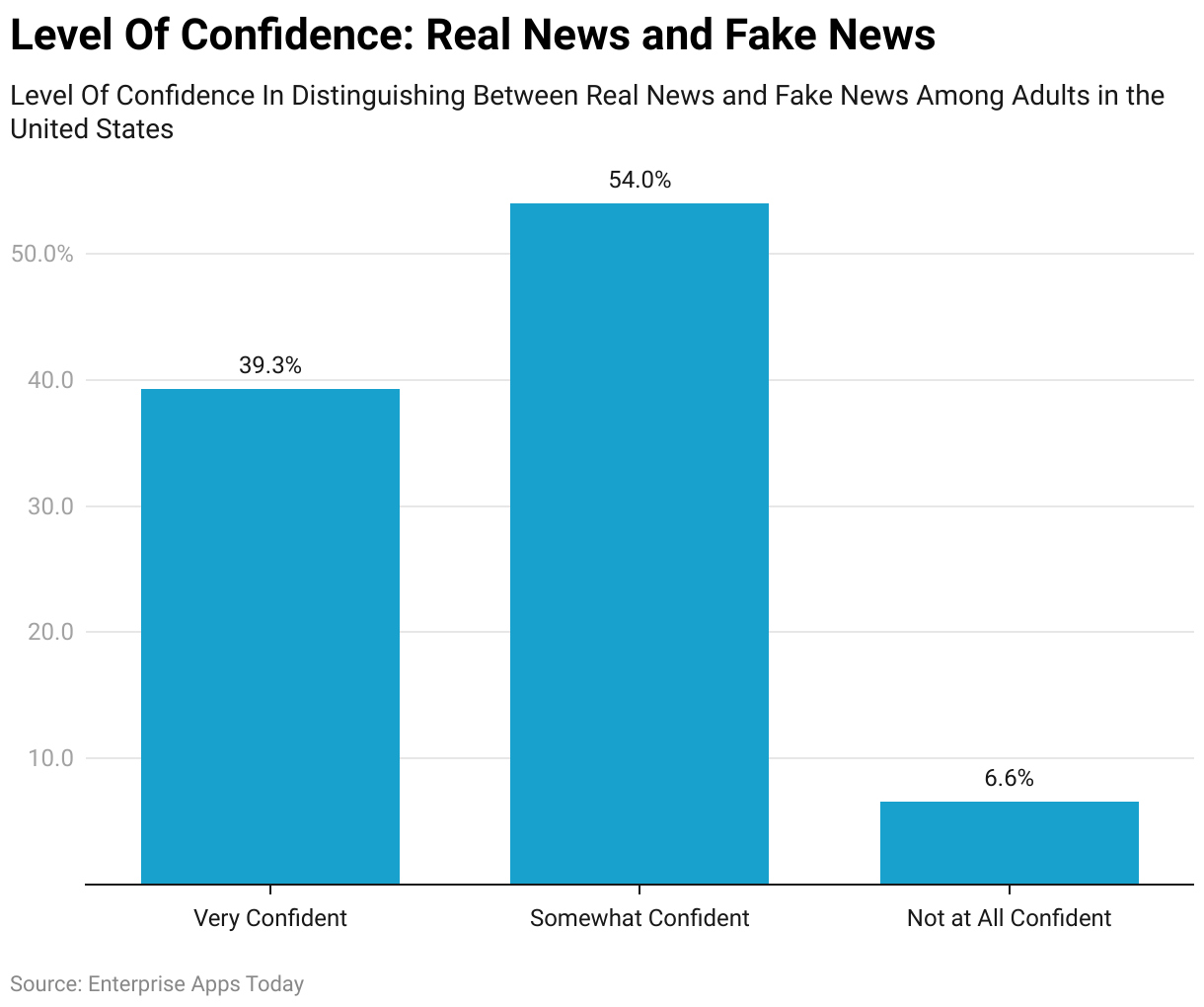 (Reference: Statista)
(Reference: Statista)
In December 2020; a survey was taken which revealed that 39.3% of American citizens aged 16 or above were exceedingly confident; in their ability to differentiate between true and false information. In contrast; only a small fraction of 6.6% reported a lack of trust; in their capacity to do the same. The majority; 54%, expressed a moderate or greater level of trust in their ability to identify disinformation.
Editor’s Choice
- Fake news has a significant impact on political discussions with friends and family; according to 71% of the participants.
- During Q2 of 2020; Facebook removed a total of 7 million posts that were identified as containing false information.
- Based on social media statistics; a significant portion of Facebook users, specifically 56%, are unable to distinguish authentic news from fake news when the latter aligns with their preexisting beliefs.
- The ethnicity of the individual is another essential factor that determines their belief in the promotion of fake news by the media. Specifically; 30% of white Americans are of the opinion that the media is responsible for promoting fake news.
- It has been found that 32% of senior citizens hold the belief that major media outlets are responsible for spreading fabricated news.
- Approximately 41% of Americans deliberately avoid consuming the news.
- The New York Times is reputed to be highly precise according to 21% of its readership.
- The vast majority of people; approximately 83%; have stated that the circulation of false news has a negative effect on the political climate of their country.
- A fabricated news platform in France generated over 11 million interactions; on a monthly basis.
What is Fake News?
Fake news, designed to mislead people and spread false information, is material deliberately created or altered and presented as news. Typically shared across social media platforms or news websites, it can often be difficult to differentiate it from legitimate news stories.
Fake news comes in many forms; false information, deceptive headlines, altered photos or videos, and biased reporting are just some of its many manifestations. Fake news often plays on people's emotions or preexisting views in order to manipulate people into reading it and may have harmful repercussions for both themselves as individuals and society.
One of the main risks of fake news is its potential to undermine trust in democratic institutions and conventional media outlets, having an adverse effect on public dialogue and decision-making processes. Furthermore, misleading information may spread rapidly through social media platforms thereby aiding in spreading false narratives and disinformation.
Governments and other groups often employ fake news as an information warfare strategy to spread misinformation or alter public sentiment. This can be especially problematic during elections or other political gatherings where fake news could potentially influence voters or threaten the validity of democratic processes.
2021 research shows that; American consumers aged 14 or older identified false news as an increasingly; pressing problem across their nation; 44% strongly agreed, while only 9% disagreed; some respondents weren't sure; whether false news and disinformation constituted a serious threat or not.
How Often Do You See Fake News?
- Many people turn to social media sites for news updates, revealing an alarming level of fake news on these platforms. As evidenced by these statistics on inaccurate information posted via social media platforms.
- Americans believe that 61% of social media news stories are inaccurate, which is alarming considering many Americans depend on these channels for daily news consumption.
- Ten percent of Americans have admitted to spreading false information through social media platforms, contributing to its rapid spread and expansion. Some people even admitted to being responsible for spreading fake news and alternative facts in an attempt to maintain an audience online. This highlights why fake news should be addressed more broadly as some citizens admit responsibility for spreading misinformation or alternative facts themselves on these social platforms.
- Adults in the US reported finding misleading information on social media in 67% of cases, and have also read false news pieces posted to these platforms.
- Facebook posts from outlets that disseminate false information get six times more interactions than those from reliable news sources.
- Facebook statistics and social media are filled with fake news that many concerned people share without even realizing it is contributing to spreading false information. Many may become entranced by stories without realizing their role in spreading misinformation.
Statistics on Trust in Social Media
As concerns about false news and disinformation on these platforms have grown, trust in social media as a news source has substantially declined over time.
- 2022 analysis conducted by Digital News analysis demonstrated that only 26% of respondents trusted news from social media as an overall source, far lower than conventional media channels (59%) and websites solely providing online news (34%).
- According to research from the Reuters Institute for the Research of Journalism conducted in 2021, only 26% of respondents in the United States trusted news received through social media, while 44% trusted conventional media channels and 36% relied solely on news websites as sources.
- New York University researchers recently conducted a 2020 study and found that people who primarily access news through social media are more likely to share inaccurate or false information and become involved with conspiracy theories.
- According to research by the University of Cambridge, inaccurate and conspiracy theories surrounding the COVID-19 pandemic were pervasive across social media platforms in 2022, with false material about its sources viewed millions of times, according to this research study.
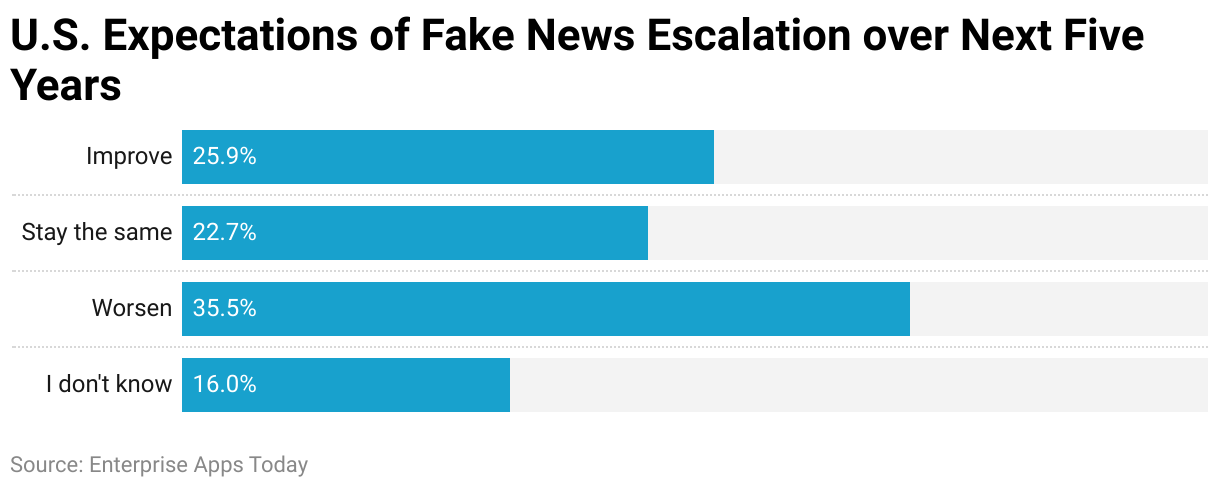
According to a December 2020 US study; 35.5%; of respondents believed; the fake news problem; will worsen over the next five years; 25.9% felt things would improve and another similar percentage; thought things would remain the same.
General Statistics on Fake News
Studies have illustrated how prevalent and pervasive false news has become on social media and news websites in recent years, making it an ever-present threat to society.
- Pew Research Center survey respondents (48%) admitted to viewing news articles or photos that they later discovered to be wholly false in 2022, with 64% of those who obtain news via social media reporting such encounters; further, 34% of American adults admitted sharing an image or news report online that later proved to be falsified.
- According to the Reuters Institute for the Research of Journalism in 2020; Facebook users viewed over 4.3 billion counterfeit or deceptive news items in the 10 months preceding the U.S. presidential election. The same study revealed that right-wing and conservative social media users were more likely to share fabricated news articles than their liberal or left-wing counterparts.
- In 2018, MIT conducted a study that found fake news articles were 70% more likely to be retweeted on Twitter than legitimate news articles. The study analyzed the spread of 126,000 stories tweeted by three million individuals over the course of 11 years.
- According to a 2022 Digital News Survey survey of respondents from 46 nations, 37% were concerned by incorrect or misleading online information circulating across 46 nations. Of those polled, only 26% trusted news posted to social media channels – making this source the least dependable source.
- According to research conducted at Cambridge, false and misleading information and conspiracy theories regarding the COVID-19 pandemic were widespread across social media platforms in 2021, and seen millions of times on these platforms, according to this research study.
- According to a 2020 study conducted by Oxford University academics, 13% of Twitter users posted material from websites classified as “junk news” or propaganda during the 2016 U.S. presidential election cycle. Trump supporters shared these websites more often than Clinton supporters did.
- 51% of poll participants agreed that political gain being gained through falsified information via fake news outlets is cause for alarm; particularly in India where fake news and misinformation spread via social media have become an increasing problem. Most Indian respondents also shared similar worries regarding fake news being an issue due to various reasons.
Fake News Statistics Effect on Politics
Politics across the world has been profoundly altered by fake news.
- In 2021, The Pew Research Center reported that 64% of Americans believe false news has greatly altered their understanding of current events and fundamental truths.
- According to a similar survey; Republicans and Democrats perceive false news differently in regard to its effect. Only 43% of Republicans agree with Democrats that Russia or other foreign governments could attempt to influence the 2020 presidential election with misleading information; while 73% of Democrats hold this belief.
- Researchers from Ohio State University discovered in 2020 that people's trust in major media outlets had decreased due to exposure to false news items during the 2016 US presidential election cycle. Their study also demonstrated a correlation between false news items and rising conspiracy theory acceptance and decreased media trust.
- Users associated with the political right are more likely to share false news on social media platforms, according to a 2021 study conducted by the Reuters Institute for the Study of Journalism. Additionally, for individuals who identify as political conservatives were more likely to spread incorrect information regarding the COVID-19 outbreak.
- Fake news has been used in various nations to influence political outcomes. A 2020 study conducted by academics at the University of Warwick discovered that false information significantly affected Britain's referendum vote for Brexit in 2016.
- According to research by the Brazilian Association of Investigative Journalism, fake news was used effectively during Brazil's 2018 presidential election to boost Jair Bolsonaro and destroy Fernando Haddad as the potential front-runner.
- India has seen its share of fake news causing political and religious divisions. A 2018 investigation by Alt News discovered that Muslim-hating violence was fuelled by false news headlines about cow slaughter, specifically.
- 51% of poll participants agreed that information distorted or falsified for political gain; through fake news outlets is cause for alarm; including in India where social media-based fake news and misinformation have become an ever-growing problem. A majority of Indian respondents also voiced similar fears regarding fake news as an issue for various reasons.
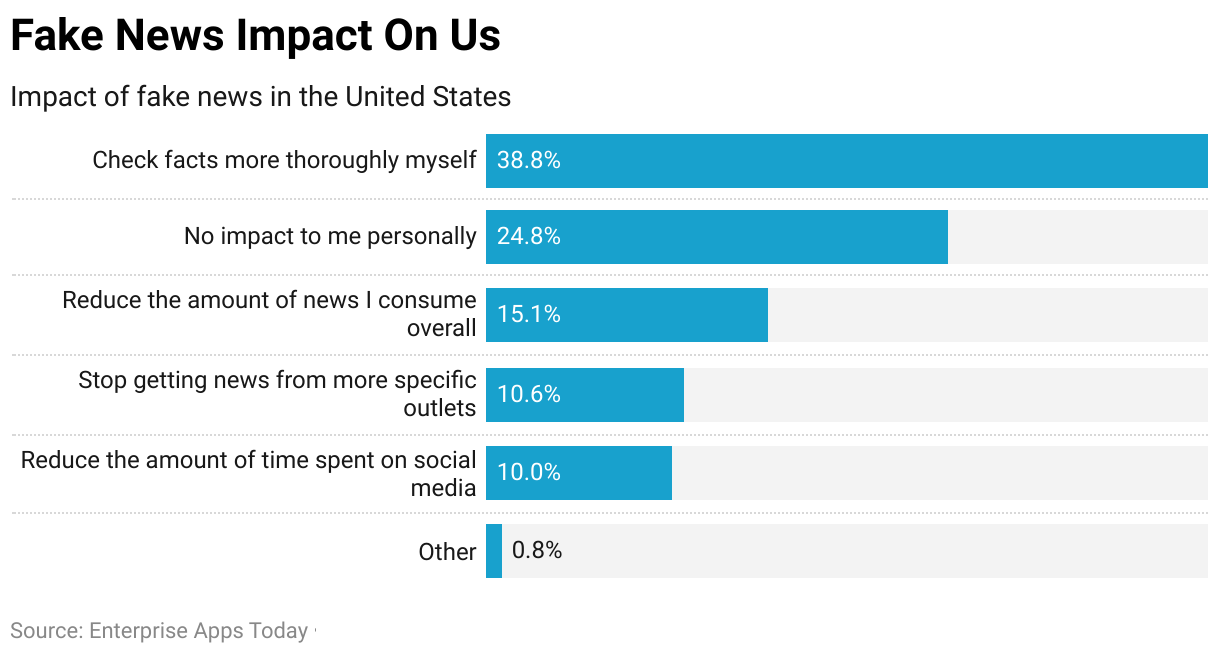
Trust in Social Media By Region and Demographic
Trust levels differ dramatically among different communities and demographic groups when it comes to media.
- Finland had the highest level of media trust, with 66% of respondents from a 2022 study from the Reuters Institute for the Study of Journalism believing their news either most or all of the time; according to a 2022 poll conducted by that institute. Greece, on the other hand, experienced only 24% who always or most often trusted what was being reported in media sources.
- This same study showed that media trust had decreased among people across multiple nations; for example; only 29% of US respondents indicated they always or mostly trusted news, down from 40% in 2019.
- Democrats in the US are more likely than Republicans to express trust in news media sources, according to a 2021 Pew Research Center study. Of all Republicans surveyed only 10% stated they trusted them compared with 73% who felt similarly.
- In another study conducted by the same researchers, younger Americans displayed lower trust in media than their elders; only 16% of those 18 to 29 indicated having faith in it compared with 33% among people 65+.
- According to research conducted by the European Broadcasting Union in 2021, public service media (PSM) are more trusted across Europe than commercial media outlets; more than half of respondents in 19 of 33 nations polled reported trusting PSM compared with just six nations where more than half reported doing so for commercial media outlets.
- This study also discovered that those with higher incomes and education levels tend to trust Public Service Media more. For example, individuals in Germany with a university degree were significantly more likely to trust PSM than those with only a secondary school education (51% of the population).
- According to a 2021 Edelman Trust Barometer study, the COVID-19 outbreak significantly enhanced media trust across several nations, rising from 35% in 2020 to 42% by 2021 in the United States alone.
These figures emphasize the complexity and variety of media trust across geographies and demographic groups. While there may be significant variance among nations based on political affiliation, age, education level, money available for spending, or any number of other characteristics affecting media trust levels; confidence in many nations tends to remain low with regard to media. Initiatives that promote openness, accountability, diversity, and fair news coverage could help restore this trust in many instances.
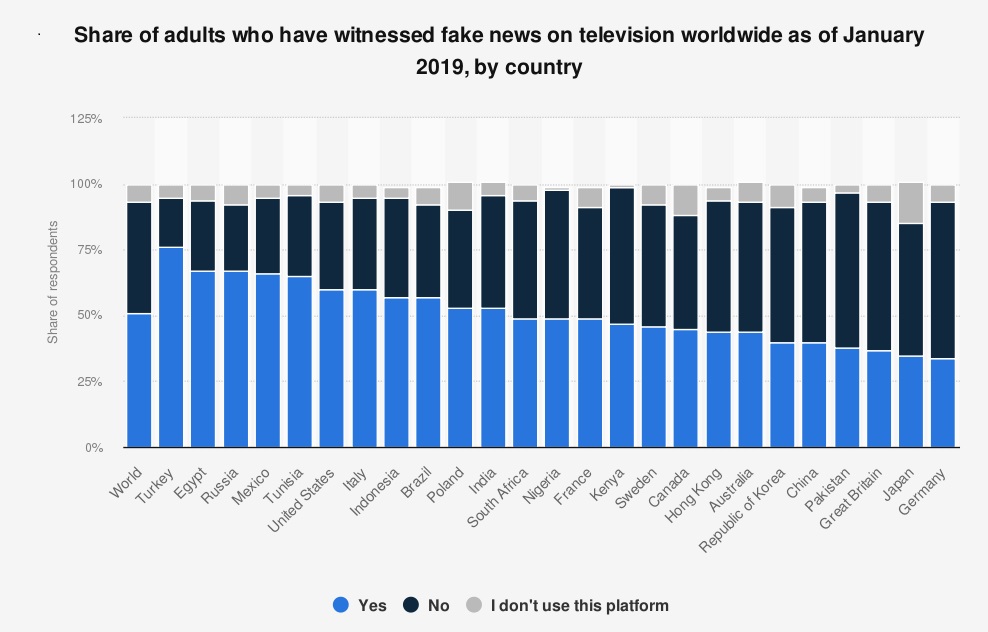
As of January 2019; this statistic demonstrates the percentage of adults across each nation; who had seen false news on television as of January 2019. Turkish people were most likely to report witnessing false information on TV – with 76% having done so according to those responding. Germany; Japan; Great Britain; and Pakistan reported having less than 40% of respondents claimed they had witnessed false information on television.
Impact of Fake News on People and The Economy
Fake news can have a significant effect on people and the economy; often with devastating results.
- Informational Inaccuracy: False information spread by fake news can mislead individuals and affect their actions in dangerous ways, leading them to take decisions they later regret or that have severe repercussions for themselves – such as providing bad health advice that leads to injuries; or giving inaccurate candidate profiles which might sway election outcomes.
- Public Trust: Fake news can erode public faith in news media and other information sources, leaving people more uncertain and uncertain than before – this makes wise judgment more challenging to come by.
- Economic Impact: Fake news can have economic implications by altering consumer habits and market trends, such as altering investor decisions in ways that harm stock markets. False information concerning company performance could influence them negatively, potentially harming stock exchanges.
- Political and Societal Impact: Fake news can exacerbate political and societal divisions by reinforcing preexisting prejudices and opinions, making it more challenging for individuals to communicate effectively and collaborate towards finding solutions together. As such, political dialogue may become harder to access in this environment.
- Cybersecurity: False news can also be used as a weapon in online criminal activities, including phishing schemes that use it to trick individuals into divulging personal data.
- International Relations: Fake news' effects can be felt globally. False reports could be used as propaganda techniques against an administration or political situation by other countries.
- Health and Safety: In the midst of COVID-19's rapid spread, inaccurate information regarding its treatments quickly spread, prompting risky behaviors like taking unproven therapies or disdain for public health precautions such as mask use or social isolation.
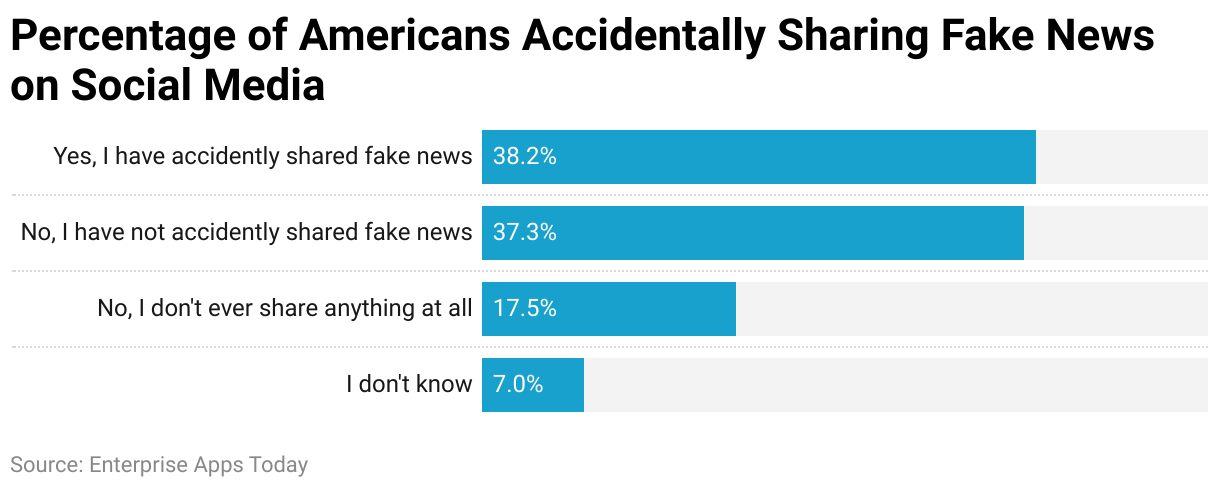
According to a poll conducted in December 2020; 38.1 percent of US news; consumers unwittingly posted false information onto social media platforms without knowing it; another percentage either agreed or disagreed with this assessment and another 7% was still uncertain whether they had unknowingly spread falsehood online.
Fake News and Covid-19
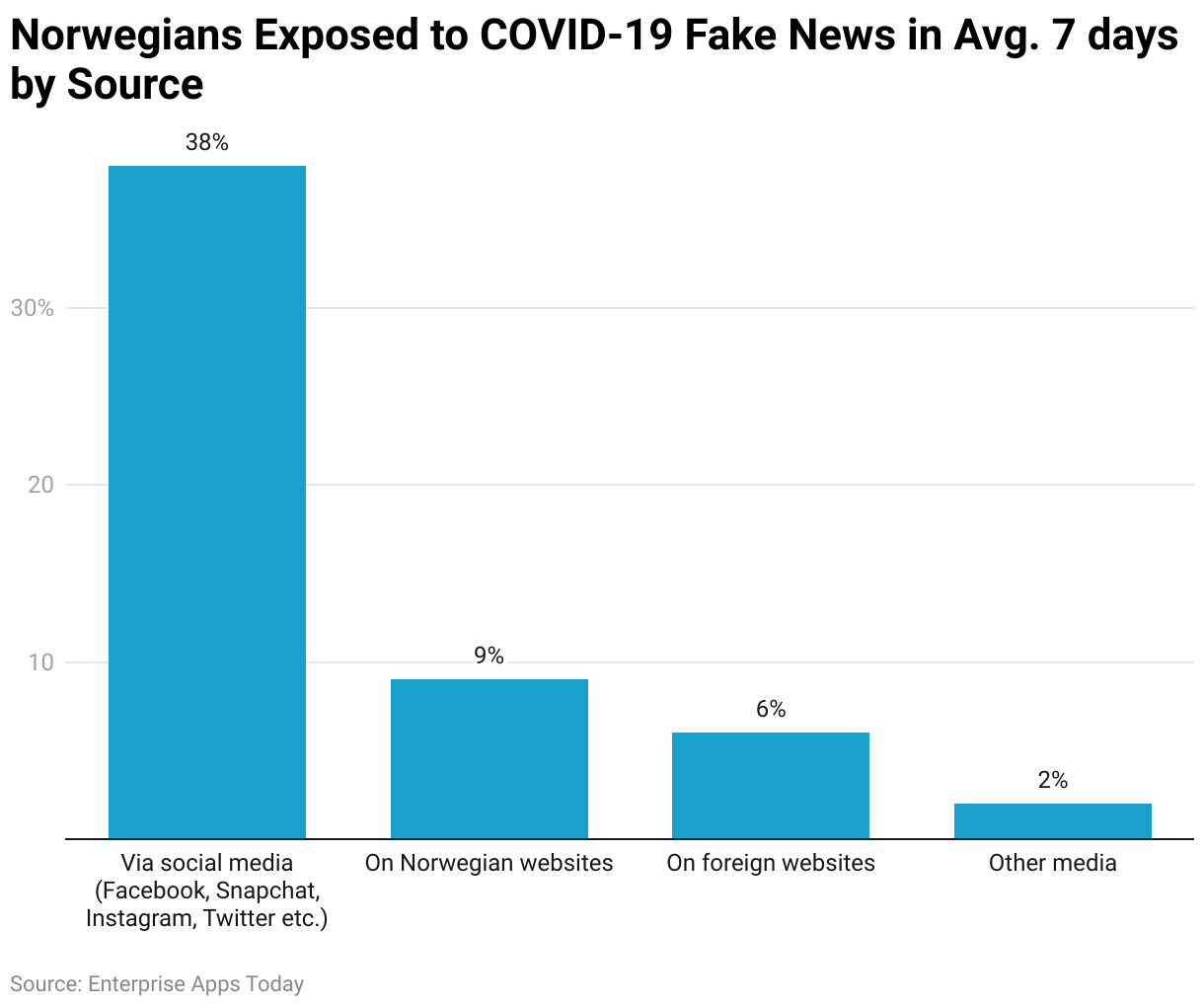
According to a poll conducted in March 2020; over half of the Norwegian public has experienced false information related to coronavirus. Three-eighths (38%) claimed they saw such misinformation online such as on Facebook, Instagram, or Snapchat; Norway's first coronavirus case was announced on February 26, 2020.
Fake news and disinformation have spread more quickly due to the COVID-19 outbreak. With many false claims and conspiracy theories emerging online as a result of COVID-19's outbreak, disinformation campaigns have spread further online than ever.
- According to research by the Reuters Institute for the Study of Journalism conducted in 2022, inaccurate information related to COVID-19 has been widely disseminated over the last year. Some forms of incorrect information included assertions regarding the efficacy of therapies, the severity of illness, and the source of the virus.
- According to a 2022 Pew Research Center study, almost four out of ten Americans (39%) reported seeing at least some misleading or inaccurate information related to COVID-19 in the past month. Even higher percentages (54%) of individuals who primarily receive their news via social media reported encountering misleading material – an even larger share than reported among general populations.
- Researchers from Cambridge University conducted a 2021 study that revealed that COVID-19 conspiracy theories were widespread on social media platforms and incorrect material regarding its origin had been seen millions of times.
- According to a 2022 study from Oxford University researchers, those who heavily rely on social media for news are more likely to believe false claims about COVID-19, such as its creation intentionally in a laboratory.
- Researchers from the University of Washington found that reduced compliance with public health recommendations such as wearing masks or practicing social distancing was linked with exposure to inaccurate and false news regarding COVID-19.
- The World Health Organization (WHO) identified falsified information as one of the major obstacles to an international response to COVID-19 in their 2022 study, calling for measures to combat it and promote accurate and trustworthy sources of information regarding this epidemic.
How to Stop Fake News from Spreading?
Though fake news can be an increasingly serious threat, individuals and organizations alike can take steps to combat it.
- Verify Sources: One effective strategy against false information is verifying information sources' credibility. Be sure to confirm that any material presented by them is true and reliable before sharing an article or news item online. Use fact-checking sites such as Snopes, FactCheck.org, or PolitiFact for this task.
- Apply skepticism: Apply skepticism when reading news reports that seem amazing or too good to be true. Before sharing an item with others, further, investigate it if there are signs that something seems amiss.
- Promote media literacy: Media literacy refers to an individual's capacity for comprehending; evaluating, and producing media. Promoting media literacy may enable individuals to use news and information critically while strengthening their ability to differentiate fact from fiction.
- Emphasize on fact-checking: Verifying the accuracy of the content found in news articles, political commercials, and social media posts is known as fact-checking. Fact-checking groups employ professional journalists to examine claims made by public figures, journalists, and politicians.
- Encourage ethical reporting: Journalists and media outlets have the responsibility of reporting news in an honest and factual way, confirming sources, double-checking information; identifying any discrepancies, correcting any mistakes found, and providing background and context details so readers may fully comprehend its significance.
- Government regulation: Government rules mandating media outlets adhere to moral journalistic standards are another effective means of combatting false news. This could entail mandating that media outlets post corrections for errors or disclose funding sources.
- Digital Solutions: Social media platforms and other digital businesses must take measures to combat false news reports, such as using algorithms to recognize and flag them; giving consumers options to detect and flag false information themselves is another effective way of fighting back against fake stories.
Final Words
Fake news has become a widespread problem that threatens individuals, societies, and economies alike. It can polarize politics, break public trust, spread false information, and promote false beliefs – potentially having long-term ramifications on market patterns and investor decisions that could potentially have serious repercussions for an economy's health.
The COVID-19 pandemic has brought to light the risks of misinformation when it comes to public health and safety. Misleading statements about COVID-19 virus treatments might result in actions that put individuals in jeopardy.
Fake news must be combatted using a comprehensive approach involving people, organizations, and governments. To curb its spread and ensure reliable information sources remain available to the public, media literacy, fact-checking, responsible journalism practices, laws, and media literacy can help to promote accuracy. As information has the power to spread faster than ever, fighting fake news requires us all to take collective steps against its proliferation in order to support ethical journalism practices that help individuals make informed decisions based on accurate facts without adversely impacting society or economies in any way.
FAQ.
Simply stated, media literacy refers to your ability to accurately evaluate the information you create or receive through technology and media outlets. It includes being able to distinguish reality from opinion as well as understanding how this form of influence may impact individuals. With technology becoming an ever-present force today, media literacy provides the essential foundation for informed and critical thought while safeguarding individuals against unnecessary influence or falsehoods presented through these outlets.
While former US President Donald Trump may have made popularized it, journalists first used this term in the late 19th century when disparaging competing newspapers and periodicals with similar stories.
There are various approaches to answering this question. As one starting point, 62% of internet users consider 62% of online news sources and platforms fraudulent while 87% feel fake news has an adverse effect on political life - making the problem even worse through technology like the internet.
It can be hard to ascertain the precise quantity of fake news stories, yet up to 86% of all internet users admit having fallen for false reports at one time or another. While this figure could be taken as representative, given it involved only 25,000 participants from 25 different nations in its research sample, thus missing the full scope of the issue.

Barry is a lover of everything technology. Figuring out how the software works and creating content to shed more light on the value it offers users is his favorite pastime. When not evaluating apps or programs, he's busy trying out new healthy recipes, doing yoga, meditating, or taking nature walks with his little one.

